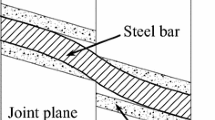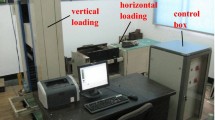Summary
Bolting has been used in rock engineering for many years, but present knowledge and research experience supply only limited information concerning the action of rock bolts and the determination of the bearing capacity. To improve this unsatisfactory situation a test-based research programm has been carried out at the Rock Mechanics Laboratory of the Swiss Federal Institute of Technology.
Based on recent publications treating rock bolting in theory and practice, about 70 laboratory and field tests have been carried out in order to explain the mode of action of fully-bonded, untensioned rock bolts in stratified or jointed rock masses. A three-dimensional model of a laboratory test was implemented using the Finite Element Method, with the aim to check the test observations and to furnish complete information for all stages of the shear tests.
Through a systematic variation of the principal bolting parameters, their influence on the increase of the shear resistance of joints has been quantified. Formulae have been developed for the evaluation of the bearing capacity of fullygrouted bolts and for the prediction of the required shear displacements.
Similar content being viewed by others
References
ADINA: Automatic Dynamic Incremental Nonlinear Analysis. User Manual, ADINA Engineering 9/81.
Azuar, J. J. (1977): Stabilisation des massifs rocheux fissurés par barres d'acier scellées. Rap. de Rech. LPC No. 73, Lab. Central des Ponts et Chaussees. Nov. 1977.
Azuar et al. (1979): Le renforcement des massifs rocheux par armatures passives. Proc. IV. Int. Conf. ISRM, Montreux 1979I, 23–30.
Bjurström, S. (1974): Shear Strength of Hard Rock Joints Reinforced by Grouted Untensioned Bolts. Proc. III. Int. Conf. ISRM, Denver 1974,IIB, 1194ff.
Dight, P. M. (1982): Improvement to the Stability of Rock Walls in Open Pit Mines. Ph. D. Thesis, Monash University, Australia, 1982.
Egger, P., Fernandez, H. (1983): Nouvelle presse triaxiale — Etude de modèles discontinus boulonnés. Proc. V. Int. Conf. ISRM, Melbourne 1983, 171–175.
Egger, P., Spang, K. (1987): Stability Investigations for Ground Improvement by Rock Bolts at a Large Dam. Proc. VI. Int. Conf. ISRM, Montreal 1987, 349–354.
Haas, C. J. (1981): Analysis of Rockbolting to Prevent Shear Movement in Fractured Ground. Journ. of Mining Engineering6, 698–704.
Haas, C. J. (1976): Shear Resistance of Rock Bolts. Transactions,260, 32–41.
Hibino, S., Motojima, M. (1981): Effects of Rock Bolting in Jointy Rock. Proc. Int. Symp. Weak Rock, Tokyo 1981, 1052–1062.
Schubert, P. (1984): Das Tragvermögen des mörtelverstzten Ankers unter aufgezwungener Kluftverschiebung. Ph. D. Thesis, Montan-Universität Leoben, Austria, 1984.
Spang, K. (1988): Beitrag zur rechnerischen Berücksichtigung vollvermörtelter Anker bei der Sicherung von Felsbauwerken in geschichtetem oder geklüftetem Gebirge. Ph. D. Thesis, No. 740, Federal Institute of Technology, Lausanne, Switzerland, 1988.
Author information
Authors and Affiliations
Rights and permissions
About this article
Cite this article
Spang, K., Egger, P. Action of fully-grouted bolts in jointed rock and factors of influence. Rock Mech Rock Engng 23, 201–229 (1990). https://doi.org/10.1007/BF01022954
Issue Date:
DOI: https://doi.org/10.1007/BF01022954




